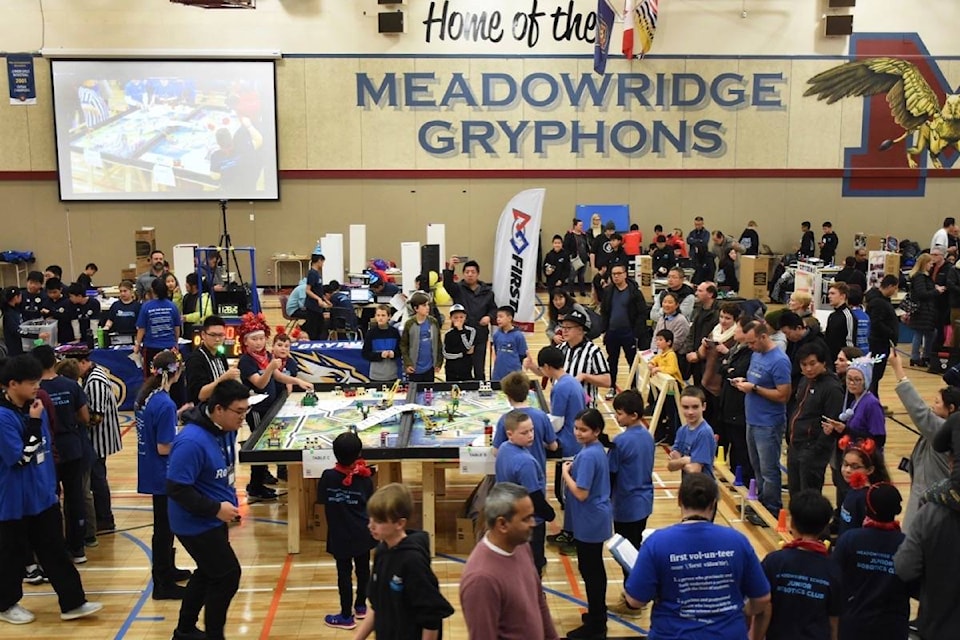Robots can come in all different shapes and sizes.
But the LEGO MINDSTORMS robots at the FIRST LEGO League competition hosted by Meadowridge School on Sunday had to be entirely student built and preprogrammed to complete a series of tasks on a pre-designed course mapped out on a table.
Members of the Meadowridge robotics club participated in this years competition themed City Shaper.
There were 32 teams at the event, from Grades 5 to 8, including 36 FIRST LEGO League students from Meadowridge and around seven Junior FIRST LEGO League students, Grades 2-3, who held their own demonstration.
Challenges vary, explained Meadowridge robotics club coach Carrie Mohoruk, who helped organize the event.
Delivering certain blocks into each circle gets points, if the colours match the circle there are more points on top of that and then there are some upgrade blocks gets even more points, she said. Then if the robots are able to trigger the crane that drops a block they can get even more points, along with releasing an accessibility swing.
Teams are given only two and a half minutes to get as many points as they can.
READ MORE: Maple Ridge school hosts FIRST LEGO competition
And, said Mohoruk, teams can only touch the robot in specific areas or else they lose points.
There can only be two children at the table at a time to operate the robot and they have three chances to get it right.
Their top score is what counts.
Each team has a launch plan that they work on ahead of time that gives them the order they are doing the challenges in.
You have to be careful about changing that launch plan up, said Mohoruk, because it can knock other things on the table and take away points from the team.
Team Etc., made up of Grade 7 students from Meadowridge, wanted to keep their robot simple because this was their first time competing at the FIRST LEGO event.
Their robot, named Jordon, took the team almost five hours to make, as they had to change the attachments numerous times to figure out what would work the best.
Qianru Guo said finding a way to push the blocks with the attachment was the most challenging. Amy Xu said figuring out whether to use rotations or degrees to program the robot’s wheels to turn was also a challenge for the team. Xu discovered degrees is more accurate.
Bella Cheung, Fiona Yang and Razaan Sayeh, each learned how to build the attachments, how they work and finding the right pieces to make up the structure of the robot.
Team Zoomers, another Meadowridge team, called their robot Short Box, and made sure there were lots of holes and options available for moving attachments around. But during the three weeks they worked on their robot design they decided to focus on one versatile attachment that can be put in two places for the competition.
“A lot of other teams have big box-ish things that they can put on and off and we think that would take a lot of time,” said team member Grade 7 student Joshua Liu describing other teams’ attachments.
In competition, even though all of the programs worked on the team’s robot, they mixed up their launch plan.
Grade 8 team member Henson Han said next time they are going to be more organized.
But the robot challenge is only one part of the competition. Teams also have to come up with an innovation project that they have to research and present. This years topic was cities of the future.
Students had to look at a problem facing cities today, what is currently being done to solve the problem and their own solution.
One team at Meadowridge looked at water conservation within a city.
Their idea, said Mohoruk, was having a deeper reservoir under the city where clean rain water harvested off buildings can be stored. So that if glaciers disappear, cities can draw from the underground reservoir during the summer months.
Another team, said Mohoruk, focused on food scarcity, coming up with an idea for a closed hydroponics system to grow food efficiently in a city.
Yet another team looked at accessibility for seniors, especially those with dementia.
Teams are then judged on a presentation about how they developed their robots and then they were judged on core values, like teamwork and fun.
Mohoruk says the reason why she likes the competition is the skills the students learn.
What they get out of this, she said, is they learn how to negotiate within a team, how to resolve conflicts, how to overcome challenges, how to manage their own time and their own responsibilities, they take responsibility for doing the research and they learn how to present.
FIRST LEGO League is an international program for children from around 9-years to 16-years old that was created by FIRST and the LEGO Group in 1998 to get children excited about science and technology.
FIRST is a not-for-profit charity founded in 1989 by American entrepreneur and inventor Dean Kamen to inspire young people’s interest and participation in science and technology.
More than 310,000 children in around 100 different countries will be taking part in the 21st annual competition that is taking place over the season spanning 2019 and 2020.
Winners of the competition will have the opportunity to compete in provincials and then winners there will compete North America wide at the April competition in Texas.
cflanagan@mapleridgenews.com
Like us on Facebook and follow us on Twitter
